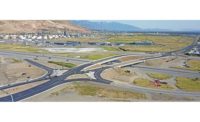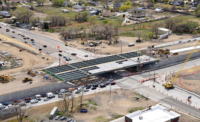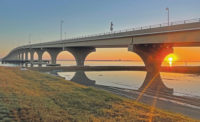SR-172 (5600 West) Railroad Crossing
Salt Lake City
Best Project
Submitted by: Michael Baker International
Owner: Utah Dept. of Transportation
Lead Design Firm/Civil/Structural Engineer: Michael Baker International
General Contractor: Wadsworth Brothers Construction
More than 15,000 vehicles travel S.R. 172 (5600 West) daily in Utah’s Salt Lake Valley, but an at-grade crossing with the Union Pacific Railroad was creating up to eight hour delays on this two-lane corridor.
To resolve this issue, crews widened 5600 West from two lanes to five along a three-mile section, added a grade-separated crossing over the railroad and designed a shared-use path along the newly widened corridor. The design team also realigned 700 South, extended a culvert and revised ramps at the Interstate 80 interchange.
The crossing is Utah’s largest project to use a digital design-bid-build delivery, which allowed the team to account for all disciplines in one place. A fully 3D model was developed that became the plan contractors used to develop their bids. It also illustrated to stakeholders how the road and crossing would align over the railroad. One of UDOT’s goals is to have a digital twin recreation of all its existing assets. A 3D model during original design and construction, as on this crossing, means the department won’t have to perform new surveys and create new models.

Photo courtesy of Michael Baker International
Coordination for the new structure over the existing tracks began as far back as 2018. The team developed a betterment agreement with Union Pacific to modify the single-span bridge to a three-span bridge, which will allow for potential future railroad expansion. In addition, the team designed a geometric alignment that allowed the existing at-grade crossing to remain open throughout construction and helped avoid costly utility relocations.
To maintain schedule and eliminate costly sewer line relocations, the team developed a geofoam embankment design for the bridge structure to prevent excessive surcharge durations and high construction costs. A 33-in. sewer line runs 17 ft underground and would have cost $3 million to replace. Instead of putting extra weight on the line with the bridge, the existing ground was over-excavated up to 4 ft, then crews installed more than 112,000 cu yd of geofoam as embankment.
The new structure over the railroad tracks not only maintains traffic along 5600 West, but also reduces safety concerns by separating vehicles and trains while also eliminating vehicle emissions caused by traffic jams.
-Railroad-Crossing-02.jpg?1700515658)




Post a comment to this article
Report Abusive Comment